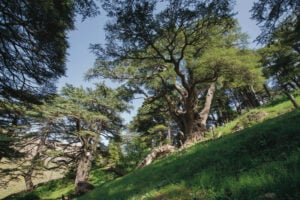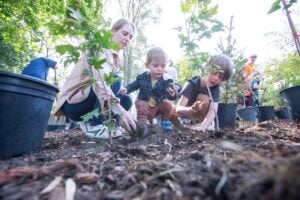
Environment
The importance of forests for our survival
An in-depth look at how trees work to keep us alive and the value of old-growth forests
- 2431 words
- 10 minutes
Travel
Kauri trees were logged to the brink in the 19th and 20th centuries and are now vulnerable to a fungal disease, but new Maori-led stewardship programs offer hope for New Zealand’s forest giants

On a darkening April evening in the ancient Waipoua Forest in New Zealand’s Northland region, the only sounds are the rustling leaves of the gigantic trees soaring above, the whispering of glowing silver ferns — an unofficial national symbol — and the clear, tuneful calls of large black tuis, a native bird with a feathery white tuft at the throat.
I’m with a Maori guide named Charlie Naera on the Footprints Waipoua tour, and we’ve been walking through the dim forest, using little flashlights to keep our bearings on the boarded path. As we walk, Naera has been sharing part of the Maori story of creation: how Mother Earth and Father Sky, whose embrace had so far kept the world dark, were forced to break that embrace when their son, Tane Mahuta, grew tall between them, and the world was bathed in light.
There is a reason Naera tells this story: We are in one of the world’s last remaining kauri forests, and he is about to light up the world’s largest living kauri tree. Its name? Tane Mahuta: Lord of the Forest.

I first heard of the kauri (pronounced kah-oo-ree), the world’s third-largest tree after two types of sequoia, when I read Annie Proulx’s epic 2016 novel Barkskins, about man’s historic destruction of much of the world’s forests. Once the loggers of North America had exhausted supplies of white pine and other large trees there, they turned their attention in the early 1800s to New Zealand. Settlers had been clearing the land of kauri trees to make way for farming, and hence the loggers discovered an even bigger and better prize. Like pine, kauri is a conifer, but unlike pine, it’s self-pruning, dropping its branches as it grows, thereby leaving few knots — which made it even more desirable to shipbuilders and furniture makers. It grows straight, to more than 50 metres tall, with girths of up to 16 metres, and has a wide crown of green leaves sitting way up top. Kauri trees can live for thousands of years.
The tree’s size and perfection are what led to its literal downfall. Its gum was prized, too. Massive blobs of kauri gum that had dropped to the earth and become buried over time would harden into chunks that have the look and feel of amber. Similar to the goldrush, “gumdiggers” came from all over the world to unearth the stuff; it was in high demand in Europe and North America because it could be melted and used as a durable varnish.
Kauri logging went practically unchecked until it was banned in the 1980s, leaving less than two per cent of the original forest standing. Most remaining kauris are in the Northland and Coromandel regions of New Zealand’s North Island. And they’re fighting a new threat: a fungal disease, Phytophthora agathidicida, or kauri dieback. Spores attach themselves to the tree’s roots and slowly kill it. There is no known cure, so the focus is on prevention.
Snow Tane is the general manager of Te Rorua, the Maori iwi (tribe) whose land encompasses the Waipoua Forest. His iwi, along with New Zealand’s Department of Conservation, is leading efforts to fight the dieback. “Our elders have long said ‘We are the forest, and the forest is us,’ ” says Snow. “If the forest isn’t healthy, then the people aren’t. We have to get past this crisis.”
Among the many measures put in place to help prevent the disease’s spread are elaborate foot-washing stations that people must pass through before entering the forest and boardwalks, so that feet don’t even touch the ground. Many areas of the forest are also off limits to visitors. And seedlings harvested from the cones of unharmed trees, deemed to be resistant to the dieback, are being planted.
Snow acknowledges that because kauri are so slow-growing, he will not live to see the fruits of this labour, nor will even his great grandkids. But he has hope. Efforts to stop the dieback are well-coordinated and there is a sense of urgency. “It’s going to be a long fight, but I have a good belief in Mother Nature.”
“If the forest isn’t healthy, then the people aren’t. We have to get past this crisis.”

Of course, I could have seen Tane Mahuta during the day — and I will come back tomorrow to do just that — but this night walk with Naera feels particularly special. “Maori traditionally do their storytelling around the fire at night,” Naera tells me, “so sharing stories and songs on a night walk is a way to honour that tradition.”
We come to a stop in an open area, and we turn off our small flashlights. In total darkness, Naera sings a spinetingling Maori-language song of praise for Tane Mahuta. Then he aims his most powerful flashlight at its trunk, and turns it on.
I’m filled with awe. It’s the largest tree I’ve ever seen. I don’t know how else to put into words the experience except to say that it’s humbling, and makes me feel so grateful that some of these trees have been spared to continue to go about their quiet, peaceful existence — perhaps for thousands more years. There’s an even older kauri in this forest, Te Matua Ngahere, or “Father of the Forest.” It’s some 3,000 years old.

After the 15-minute drive back to my hotel, the Copthorne Omapere, that feeling of awe is still with me. But so is a rumbling stomach; it’s about 9 p.m. and I’m more than ready for dinner. The fish and chips are just perfect, and as I sip a New Zealand chardonnay in the cozy candlelit dining room facing a darkened Hokianga Bay, I’m thinking about another story Naera shared: About how the bay got its name. Hokianga Kupe A Nui means, “The great leaving place of Kupe.”
So who was Kupe? According to Maori oral history, he was a Polynesian explorer and the first person in New Zealand, arriving by canoe about 1,000 years ago. As Kupe left these shores at Hokianga, to go home and tell others about this land, Kupe knew he wouldn’t be back, and declared: “Ka hoki nei au, e kore au e hoki anganui mai.” (“I now depart, and I shall never return.”)
I’ve been in New Zealand only three days, and already, I hope my fate isn’t the same as Kupe’s. But one thing is for sure: the kauris will never leave these shores again. And there’s every chance those lords of the forest, trees living today that were already 1,000-years-old when Kupe was here, will still be standing in another 1,000 years.

Are you passionate about Canadian geography?
You can support Canadian Geographic in 3 ways:

Environment
An in-depth look at how trees work to keep us alive and the value of old-growth forests

Environment
Six new mini forests were planted in cities across Canada in 2023 as part of a national pilot project to combat biodiversity loss and create new green spaces in urban areas — and the work is just beginning

Environment
Timber poaching has become “a problem in every national forest,” with an estimated $1 billion worth of wood poached yearly in North America

Environment
How a niche British Columbia-based community is working to bring attention to the importance of old-growth forests